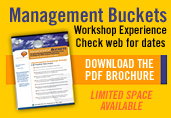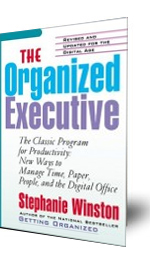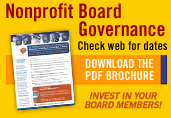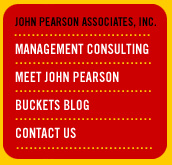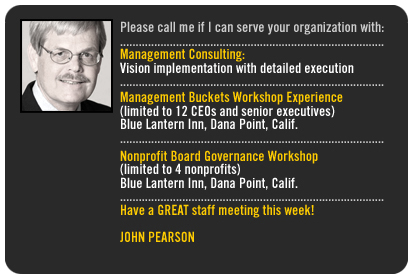
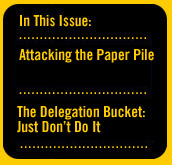
Issue No. 40 of Your Weekly Staff Meeting is about work flow. H. V. Adolt said, “We are all manufacturers. Making good, making trouble, or making excuses.” This week’s book and a tip from The Delegation Bucket will help you become a more effective executive and eliminate the excuses. Delegate your reading by sending your team members to the Buckets Blog at www.JohnPearsonAssociates.com for the last 39 book reviews.
Whether you’re blessed with an executive assistant, or you handle your own paperwork, one thing is certain—you get more paper (including email) than ever before. It’s a daily battle, but there is hope. Stephanie Winston has updated her book, The Organized Executive: The Classic Program for Productivity—New Ways to Manage Time, Paper, People and the Digital Office.
Winston’s five stages for solving the paperwork crisis are invaluable, especially her idea rich discussion of a suggested daily routine with, or without, an assistant. So ask your assistant to order and read this book and it will help you see the end of paper buildup—and improve how the two of you work together. I’ve tried to live by her cardinal rule for years: touch a piece of paper (or an email) only once. She calls it the TRAF technique: Toss, Refer, Act, or File.
Your Weekly Staff Meeting Questions:
---------------------------------------------------------------------------------------------------
1. How effective are you in the paperwork war? Rate yourself on a scale of one to 10 (one equals you’ve never won a battle, 10 equals you can teach the class).
2. In groups of three, please describe your daily routine for handling paperwork—and one problem you need help on.
---------------------------------------------------------------------------------------------------
Insights from the Management Buckets Workshop Experience
The first president of the United States Steel Corporation was Charles Schwab. He asked a consultant, Ivy Lee, for help on becoming a more effective executive. “Show me a way to get more things done. If it works, I’ll pay anything within reason.” Lee introduced Schwab to the To Do list and suggested that Schwab limit each day’s list to no more than six tasks. Start with the most important task and don’t go to the second priority until the first one is done. This remarkably simple—almost obvious—management tool revolutionized Schwab’s work. So he sent Lee a check for $10,000.
But you need more than a To Do list. Start a DON’T DO list. Here’s a simple tool from The Delegation Bucket. For 90 days, keep a list on your desk, or your computer, of what you will STOP doing. My friend, Tony Danhelka, calls this “selective neglect."
Face the facts. You must rigorously prune your To Do list every day, every week and every month. You can’t keep up—because the conveyor belt is hurling work at you faster than the famous pie scene on I Love Lucy.
So create your DON’T DO list with five columns: 1) Priority (A, B, or C), 2) Stop Doing Task, 3) Target Date, 4) Check one: Delegate or Abandon, 5) Done Date. (Note: for more help on The Delegation Bucket, read Issue Number 12.)
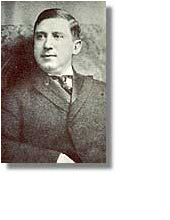
Your Weekly Staff Meeting Questions: The Delegation Bucket
---------------------------------------------------------------------------------------------------
1.What are the top six tasks on your To Do list today?
2. What are the top three tasks on your Don’t Do list—and what are the target dates for delegating them or abandoning them?
---------------------------------------------------------------------------------------------------
Note: Future dates will be announced in June for the Management Buckets Workshop Experience (two days) and the Nonprofit Board Governance Workshop (one day) at the scenic Blue Lantern Inn in Dana Point, Calif. If your organization would like to co-host a workshop, please email me.
Download the Management Buckets brochure
PS. Click “Forward Email” below to recommend this free eNews to a colleague.
